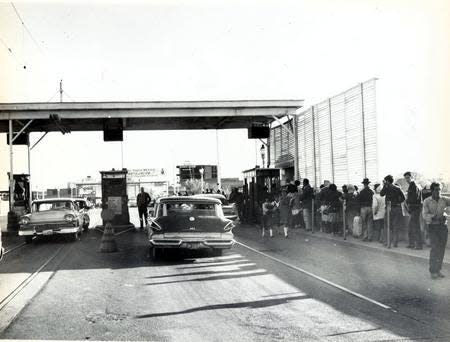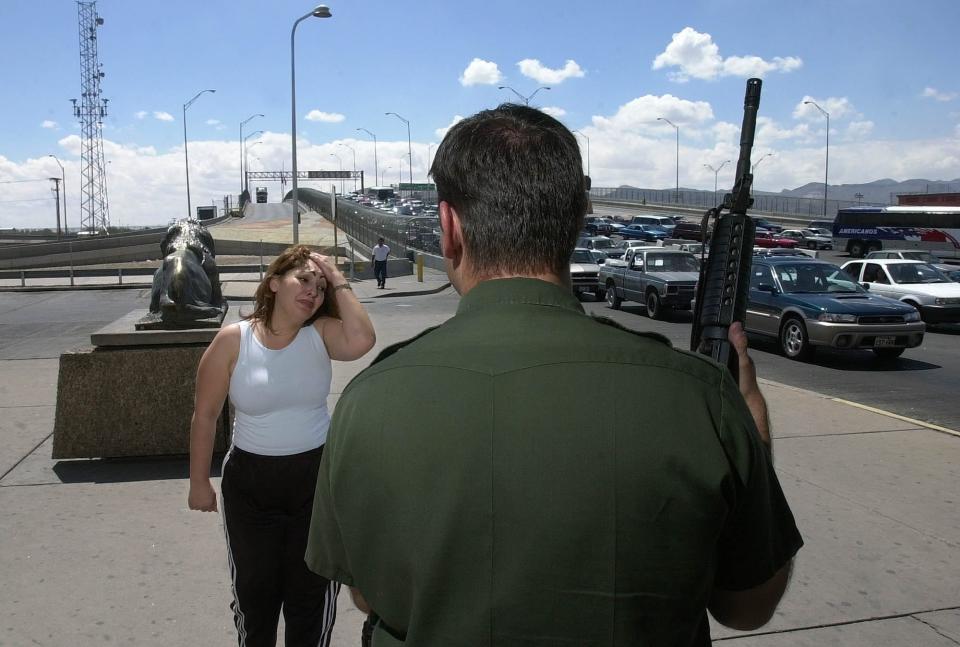Federal government has rarely stopped legal travel at the Mexican border: Trish Long
- Oops!Something went wrong.Please try again later.
In a Jan. 27 political event in South Carolina, President Joe Biden said that he would shut down the border ’“right now” if Congress passed a Bipartisan border deal and foreign aid package:
“A bipartisan bill would be good for America and help fix our broken immigration system and allow speedy access for those who deserve to be here, and Congress needs to get it done,” Biden said. “It'll also give me as president, the emergency authority to shut down the border until it could get back under control. If that bill were the law today, I’d shut down the border right now and fix it quickly.”
This week, a procedural vote to advance the bipartisan border security deal and foreign aid package with assistance for Ukraine and Israel was defeated 49-50.
Legal cross-border travel rarely halted
Although individual ports of entry into the U.S. have been closed when unauthorized immigration has become an issue, the federal government has rarely stopped legal travel at the Mexican border.
It happened briefly following the assassination of President John F. Kennedy in 1963, again after the killing of Drug Enforcement Agency agent Enrique "Kiki" Camarena in 1985 and in the wake of the 9/11 terrorist attack in 2001 and strict travel restrictions were in place during the pandemic.
Here is a look back at past border closures:

Assassination of President John F. Kennedy
After the assassination of President John F. Kennedy on Nov. 21, 1963, a mandate was issued, at 2 p.m. Mountain Time, to close the borders to vehicle and pedestrian traffic. Six hours later, that order was rescinded and U.S. Immigration officials used the Departure Control Law, authorizing the prevention of any alien or U.S. citizen from leaving the country.
The Mexican government also issued an order to close the border.
American citizens who had been trapped in Juárez when the order was issued were permitted to cross into El Paso after showing proper credentials.
The Departure Control Law closure of the border remained in place until President Kennedy's killer, Lee Harvey Oswald, was arrested.
More: 1963: Border Closed After JFK Death
Effective closings of the border
Operation Intercept: Sept. 21, 1969, customs inspectors were flown to the border from New York, Philadelphia and New Orleans as the U.S. sealed the border to everything that moved across the international boundary in an all-out fight to stop the smuggling of marijuana from Mexico.
Agents worked eight-hour shifts around the clock, seven days a week, without a day off, searching cars to the grease joints, under the hoods, in trunks, in window frames, under the seats and fenders. Luggage and passengers were carefully checked.
The operation resulted in traffic jams at the 31 border crossing points, causing delays of up to seven hours before any vehicle traffic could enter the U.S.
Three weeks later, the Mexican government announced 900,000 marijuana plants and 16 poppy fields were burned. It reported that 50 Mexican air force spotter planes were working in the states of Sinaloa, Nayarit, Jalisco, Michoacán, Guerrero, and Chihuahua.
After this display of cooperation, the pressure against the border was eased by the U.S. and Operation Intercept was replaced with Operation Cooperation on Oct. 9, 1969.
More: Killed by a cartel. Betrayed by his own? US reexamines murder of federal agent featured in ‘Narcos’
Operation Camarena: On Feb. 7, 1985, U.S Drug Enforcement Administration Agent Enrique "Kiki" Camarena Salazar was kidnapped and murdered while on assignment in Mexico. In retaliation, the U.S. Customs Service immediately launched "Operation Camarena" at 21 border checkpoints, closing nine of them and instituting time-consuming scrutiny of every vehicle at the ones that were left open. The result was two weeks of traffic jams and delays of as much as 12 hours for anyone crossing the border into the United States.
There was immediate and continuing Mexican protests, but they fell on deaf ears in Washington. Commerce across the border was grinding to a halt.
Mexican President Miguel de la Madrid Hurtado made a personal call to President Ronald Reagan. Reagan accommodated de la Madrid and within hours the border crossings were opened again.

9/11: All the main crossing points on the 2,100-mile border remained opened after the attacks, but customs and other agents were rushed to the border, where stricter searches delayed crossings.
The U.S. intensified inspections and anti-terrorist surveillance along its Canadian and Mexican borders, with more inspectors asking more questions. Bridge crossing times went from minutes to up to 15 hours.
Inspections at border crossings remain at a higher level than before 9/11.
Coronavirus: Beginning at midnight March 20th, 2020 U.S. borders with Mexico and Canada were ordered closed to all non-essential travel to prevent the spread of coronavirus.
U.S. citizens and lawful permanent residents, considered "essential" under the rules, crossed between El Paso and Juárez, as did those with U.S. work authorization or student visas. But the restrictions shut out tens of thousands of Mexican nationals with tourist visas known as border crossing cards.
The border reopened to vaccinated visitors on Nov. 8, 2021. The U.S. Customs and Border Protrction released the following:
“Non-citizen travelers are now permitted to enter the United States through a land border or ferry terminal for a non-essential reason (i.e., tourism), provided they are fully vaccinated and can present proof of COVID-19 vaccination status. Unvaccinated travelers may continue to cross the border for essential travel, including lawful trade, emergency response, and public health purposes. This shift eases long-standing restrictions on non-essential travel, consistent with public health guidance.
“When arriving at a U.S. land POE or ferry terminal, non-citizen travelers should be prepared to (1) provide proof of COVID-19 vaccination, as outlined on the Centers for Disease Control (CDC) website; and (2) verbally attest to their reason for travel and COVID-19 vaccination status during a border inspection.”
Trish Long may be reached at tlong@elpasotimes.com.
This article originally appeared on El Paso Times: Legal travel at the Mexican border rarely stopped: Trish Long

